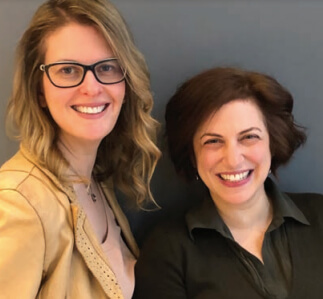Above: Ken Goldman. Jacob’s Ladder Triptych, 2015. Chromaluxe print after performance. Photos by Gideon Cohen

Mira Sucharov & Chaya Halberstam
When we conceived of the theme for this issue— travel—the worst of the COVID-19 pandemic seemed to be waning. For many of us, a resumption of travel seemed to be on the horizon. Then the Omicron variant appeared, throwing many plans into disarray. And now, as we write this, there is hope for a gradual return to sort-of normal. Will travel take on new significance for us now, when it has been denied to us for so long? Did the way we think about travel change when we were all ordered to stay at home, indefinitely? We bring to these pages thought on the topic of travel—whether conceived as hopeful or ironic or somewhere in between.
In this issue, our authors conceive of travel both personally—as researchers and teachers—and through the eyes of the subjects we study. In sections on pedagogy and the profession, writers reflect on their own travel experiences. These include sharing the challenges and opportunities posed by research fieldwork, the experience of scholar-as-tour-guide, and the task of leading study-abroad courses in moments unaffected by the pandemic. Others discuss how they had to redesign their study-abroad course for the virtual requirements of the pandemic, and how the lens of travel as depicted in film and television can highlight other Jewish Studies themes for students.
What we deliberately excluded from this issue was the theme of migration. The act of migration—both voluntary and forced—is, of course, central to so much of Jewish history, and it was well covered in the Fall 2017 issue of Perspectives. Because migration was excluded, contributors were invited to focus on travel as sojourn. The temporary nature of travel outside of the mode of migration suggests experiences ranging from the excitement of discovery and exploration through trips to major events like the world’s fair, to the taxing toil of itinerant peddling; from traveling as a volunteer military conscript out of a sense of duty to the more pleasurable activity of summer vacationing; and from the politics of protest tourism or disaster tourism to the identity-building activity of heritage tourism. Some modern travel can be experienced from home, too. Before there was virtual reality there were travelogues, which allowed readers to view real places through an author’s ideologically tinted lenses. Several contributors also invite us to consider travel in the premodern world, from mundane journeys for marriage or trade to exciting tales of shipwrecks and pirates to magical formulas that protect a traveler from danger. Finally, objects can travel, too, and the movement of material items allows some of our authors to trace intersecting and complex familial and communal networks.
The types of travel explored in these pages reveal that many of the mixed experiences we ourselves confront with travel may have always been the case: travel was exhilarating but could be dangerous; it provided opportunities for leisure but was often required for business; it could both exceed and fall short of the religious or personal impact it was supposed to have; it provided the thrill of the new but also a longing for home. We hope you will enjoy reading the Travel Issue whether from the comfort of your favorite armchair or whether you’ve just pulled it from your carry-on on your flight to somewhere you can’t wait to explore.
Chaya Halberstam
King’s University College
Mira Sucharov
Carleton University